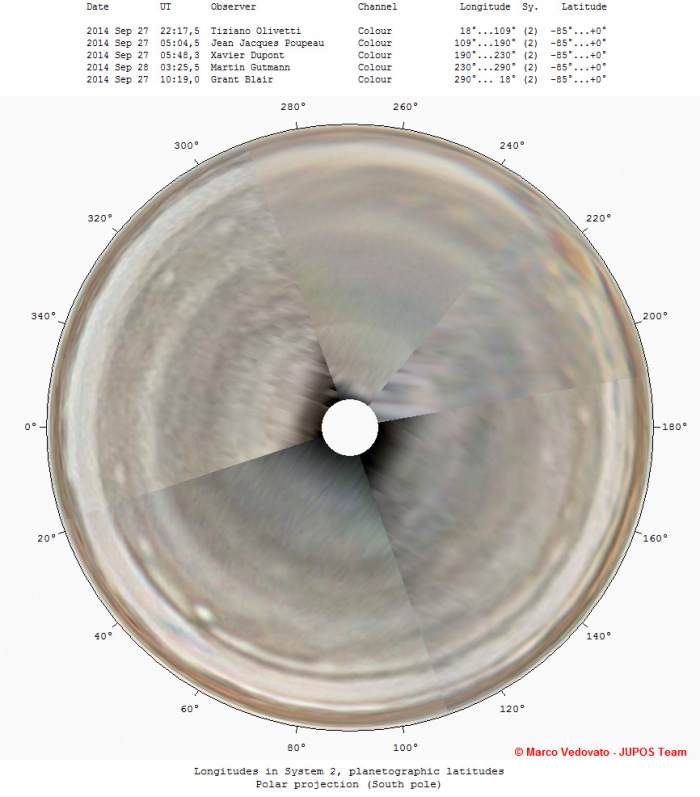Jupiter: maps, 2014 October 09-12
Da Sezione Pianeti UAI.
JUPITER: LATEST PLANISPHERES
Jupiter planispheres composed with images taken between 2014 October, 09-12
Maps prepared by Marco Vedovato with the software WinJUPOS.
Remarks about some visible features
SSTB Ovals - White spots at 40,5°S, long-lived anticyclonic circulations, named as A1, A2, A3 ... Their drifts lead them to overcome the GRS about once a year.
BA Oval - It is the result after the merging of three pre-existing ovals, during the year 2000. It is a large anticyclonic circulation, close to the latitude 33°S; in the year 2005 its color turned into a pale red. Its drift leads BA to overpass the GRS about every two years.
STB (South Tropical Belt)- Belt whose color intensity is variable as well as its latitude, variable in longitude.
GRS (Great Red Spot) - The edge is sometimes marked by a dark ring; nowadays the inner area has a pale red color. Its size is gradually shrinking.
SEB (South Equatorial Belt)- This belt periodically disappers, then an outbreak reinstates its ususal activity.
EB (Equatorial Belt)- Sometimes this thiny belt arises in the Equatorial Zone; it is a temporary feature: then the belt slowly disappears to born again during the more intensive periods of activity of the planet.
NEB (North Equatorial Belt) - This belt is the darkest one of the planet, active both in the inner area and in the edges. Periodically it broadens Northward and then it shrinks, about every four years, with production of white ovals and dark spots along the broadening edge.
WSZ (White Spot Z) - E' nata nel 1997, come una delle tante macchie bianche (anticicloniche) che appaiono a 19°N. E' caratterizzata, oltre che dalla longevità, dal moto veloce (verso longitudine decrescente), che la porta a interagire con altre macchie della sua latitudine, generalmente stazionarie nel Sistema 2. Nel mese di novembre 2013 ha assunto una debole colorazione rossastra.
NTB - Come la SEB e la NEB, è sede di periodiche eruzioni di macchie bianche e condensazioni scure, che producono velature nell'attigua zona (NTZ).
NNTB - Di aspetto variabile con la longitudine; presenta segmenti più marcati.
Piccola Macchia Rossa (LRS) in NNTZ - Poco appariscente, ma estremamente longeva: risale almeno al 1993. Si trova a 40°N, e periodicamente si colora in modo più intenso.





